Interaction Mechanism between Slags and Alkali Silicate Activators: An Approach Based on the Al Phases
Abstract
:1. Introduction
2. Materials and Methods
2.1. Materials
2.2. Methods
2.2.1. Sample Preparation
2.2.2. Characterization Methods
EDX
Degree of Hydration (DOH)
NMR
XRD
3. Results and Discussion
3.1. Degree of Hydration
3.2. Hydrate Assemblage
3.3. Discussions
4. Conclusions
Author Contributions
Funding
Institutional Review Board Statement
Informed Consent Statement
Data Availability Statement
Conflicts of Interest
References
- Shi, C.; Krivenko, P.V.; Roy, D.M. Alkali-Activated Cements and Concretes: Theory and Application; Taylor & Francis: London, UK; New York, NY, USA, 2006; ISBN 978-0-415-70004-7. [Google Scholar]
- Bernal, S.A.; Provis, J.L.; Fernández-Jiménez, A.; Krivenko, P.V.; Kavalerova, E.; Palacios, M.; Shi, C. Chapter 3 Binder Chemistry—High-Calcium Alkali-Activated Materials. In Alkali Activated Materials: State-of-the-Art Report, RILEM TC 224-AAM; Provis, J.L., van Deventer, J.S.J., Eds.; Springer: Dordrecht, The Netherlands, 2014; pp. 59–91. ISBN 978-94-007-7671-5. [Google Scholar]
- Criado, M.; Walkley, B.; Ke, X.; Provis, J.L.; Bernal, S.A. Slag and Activator Chemistry Control the Reaction Kinetics of Sodium Metasilicate-Activated Slag Cements. Sustainability 2018, 10, 4709. [Google Scholar] [CrossRef]
- Ben Haha, M.; Lothenbach, B.; Le Saoût, G.; Winnefeld, F. Influence of slag chemistry on the hydration of alkali-activated blast-furnace slag—Part I: Effect of MgO. Cem. Concr. Res. 2011, 41, 955–963. [Google Scholar] [CrossRef]
- Ben Haha, M.; Lothenbach, B.; Le Saoût, G.; Winnefeld, F. Influence of slag chemistry on the hydration of alkali-activated blast-furnace slag—Part II: Effect of Al2O3. Cem. Concr. Res. 2012, 42, 74–83. [Google Scholar] [CrossRef]
- Tänzer, R.; Buchwald, A.; Stephan, D. Effect of slag chemistry on the hydration of alkali-activated blast-furnace slag. Mater. Struct. 2015, 48, 629–641. [Google Scholar] [CrossRef]
- Bernal, S.A.; San Nicolas, R.; Myers, R.J.; Mejía de Gutiérrez, R.; Puertas, F.; van Deventer, J.S.J.; Provis, J.L. MgO content of slag controls phase evolution and structural changes induced by accelerated carbonation in alkali-activated binders. Cem. Concr. Res. 2014, 57, 33–43. [Google Scholar] [CrossRef]
- Gong, K.; White, C.E. Impact of chemical variability of ground granulated blast-furnace slag on the phase formation in alkali-activated slag pastes. Cem. Concr. Res. 2016, 89, 310–319. [Google Scholar] [CrossRef]
- Andersen, M.D.; Jakobsen, H.J.; Skibsted, J. Incorporation of aluminum in the calcium silicate hydrate (C-S-H) of hydrated portland cements: A high-field 27Al and 29Si MAS NMR investigation. Inorg. Chem. 2003, 42, 2280–2287. [Google Scholar] [CrossRef]
- Andersen, M.D.; Jakobsen, H.J.; Skibsted, J. A new aluminium-hydrate species in hydrated Portland cements characterized by 27Al and 29Si MAS NMR spectroscopy. Cem. Concr. Res. 2006, 36, 3–17. [Google Scholar] [CrossRef]
- Kunhi Mohamed, A.; Moutzouri, P.; Berruyer, P.; Walder, B.J.; Siramanont, J.; Harris, M.; Negroni, M.; Galmarini, S.C.; Parker, S.C.; Scrivener, K.L.; et al. The Atomic-Level Structure of Cementitious Calcium Aluminate Silicate Hydrate. J. Am. Chem. Soc. 2020, 142, 11060–11071. [Google Scholar] [CrossRef] [PubMed]
- Krizan, D.; Zivanovic, B. Effects of dosage and modulus of water glass on early hydration of alkali–slag cements. Cem. Concr. Res. 2002, 32, 1181–1188. [Google Scholar] [CrossRef]
- Fernández-Jiménez, A.; Puertas, F. Effect of activator mix on the hydration and strength behaviour of alkali-activated slag cements. Adv. Cem. Res. 2003, 15, 129–136. [Google Scholar] [CrossRef]
- Fernández-Jiménez, A.; Puertas, F.; Sobrados, I.; Sanz, J. Structure of Calcium Silicate Hydrates Formed in Alkaline-Activated Slag: Influence of the Type of Alkaline Activator. J. Am. Ceram. Soc. 2003, 86, 1389–1394. [Google Scholar] [CrossRef]
- Ben Haha, M.; Le Saoût, G.; Winnefeld, F.; Lothenbach, B. Influence of activator type on hydration kinetics, hydrate assemblage and microstructural development of alkali activated blast-furnace slags. Cem. Concr. Res. 2011, 41, 301–310. [Google Scholar] [CrossRef]
- Tänzer, R.; Jin, Y.; Stephan, D. Alkali activated slag binder: Effect of cations from silicate activators. Mater. Struct. 2017, 50, 91. [Google Scholar] [CrossRef]
- Gebregziabiher, B.S.; Thomas, R.J.; Peethamparan, S. Temperature and activator effect on early-age reaction kinetics of alkali-activated slag binders. Constr. Build. Mater. 2016, 113, 783–793. [Google Scholar] [CrossRef]
- Schneider, J.; Cincotto, M.A.; Panepucci, H. 29Si and 27Al high-resolution NMR characterization of calcium silicate hydrate phases in activated blast-furnace slag pastes. Cem. Concr. Res. 2001, 31, 993–1001. [Google Scholar] [CrossRef]
- Song, S.; Sohn, D.; Jennings, H.M.; Mason, T.O. Hydration of alkali-activated ground granulated blast furnace slag. J. Mater. Sci. 2000, 35, 249–257. [Google Scholar] [CrossRef]
- Wang, S.-D.; Scrivener, K.L. Hydration products of alkali activated slag cement. Cem. Concr. Res. 1995, 25, 561–571. [Google Scholar] [CrossRef]
- Wang, S.-D.; Scrivener, K.L. 29Si and 27Al NMR study of alkali-activated slag. Cem. Concr. Res. 2003, 33, 769–774. [Google Scholar] [CrossRef]
- Puertas, F.; Palacios, M.; Manzano, H.; Dolado, J.S.; Rico, A.; Rodríguez, J. A model for the C-A-S-H gel formed in alkali-activated slag cements. J. Eur. Ceram. Soc. 2011, 31, 2043–2056. [Google Scholar] [CrossRef]
- Bonk, F.; Schneider, J.; Cincotto, M.A.; Panepucci, H. Characterization by Multinuclear High-Resolution NMR of Hydration Products in Activated Blast-Furnace Slag Pastes. J. Am. Ceram. Soc. 2003, 86, 1712–1719. [Google Scholar] [CrossRef]
- Gong, K.; Cheng, Y.; Daemen, L.L.; White, C.E. In situ quasi-elastic neutron scattering study on the water dynamics and reaction mechanisms in alkali-activated slags. Phys. Chem. Chem. Phys. 2019, 21, 10277–10292. [Google Scholar] [CrossRef] [PubMed]
- Myers, R.J.; Bernal, S.A.; San Nicolas, R.; Provis, J.L. Generalized structural description of calcium-sodium aluminosilicate hydrate gels: The cross-linked substituted tobermorite model. Langmuir 2013, 29, 5294–5306. [Google Scholar] [CrossRef] [PubMed]
- Walkley, B.; San Nicolas, R.; Sani, M.-A.; Rees, G.J.; Hanna, J.V.; van Deventer, J.S.J.; Provis, J.L. Phase evolution of C-(N)-A-S-H/N-A-S-H gel blends investigated via alkali-activation of synthetic calcium aluminosilicate precursors. Cem. Concr. Res. 2016, 89, 120–135. [Google Scholar] [CrossRef]
- Burciaga-Díaz, O.; Escalante-García, J.I.; Rigaud, M. Structure, Mechanisms of Reaction, and Strength of an Alkali-Activated Blast-Furnace Slag. J. Am. Ceram. Soc. 2013, 96, 3939–3948. [Google Scholar] [CrossRef]
- Gao, X.; Yu, Q.; Brouwers, H.J.H. Apply 29Si, 27Al MAS NMR and selective dissolution in identifying the reaction degree of alkali activated slag-fly ash composites. Ceram. Int. 2017, 43, 12408–12419. [Google Scholar] [CrossRef]
- Churakov, S.V.; Labbez, C. Thermodynamics and Molecular Mechanism of Al Incorporation in Calcium Silicate Hydrates. J. Phys. Chem. C 2017, 121, 4412–4419. [Google Scholar] [CrossRef]
- Myers, R.J.; L’Hôpital, E.; Provis, J.L.; Lothenbach, B. Effect of temperature and aluminium on calcium (alumino)silicate hydrate chemistry under equilibrium conditions. Cem. Concr. Res. 2015, 68, 83–93. [Google Scholar] [CrossRef]
- Myers, R.J.; Bernal, S.A.; Gehman, J.D.; van Deventer, J.S.J.; Provis, J.L. The Role of Al in Cross-Linking of Alkali-Activated Slag Cements. J. Am. Ceram. Soc. 2015, 98, 996–1004. [Google Scholar] [CrossRef]
- Walkley, B.; Page, S.J.; Rees, G.J.; Provis, J.L.; Hanna, J.V. Nanostructure of CaO-(Na2O)-Al2O3-SiO2-H2O Gels Revealed by Multinuclear Solid-State Magic Angle Spinning and Multiple Quantum Magic Angle Spinning Nuclear Magnetic Resonance Spectroscopy. J. Phys. Chem. C 2020, 124, 1681–1694. [Google Scholar] [CrossRef]
- GB/T 18046-2017; Ground Granulated Blast Furnace Slag Used for Cement, Mortar and Concrete. SAC/TC 184: Beijing, China, 2017.
- Ismail, I.; Bernal, S.A.; Provis, J.L.; San Nicolas, R.; Hamdan, S.; van Deventer, J.S.J. Modification of phase evolution in alkali-activated blast furnace slag by the incorporation of fly ash. Cem. Concr. Compos. 2014, 45, 125–135. [Google Scholar] [CrossRef]
- Durdziński, P.T.; Dunant, C.F.; Ben Haha, M.; Scrivener, K.L. A new quantification method based on SEM-EDS to assess fly ash composition and study the reaction of its individual components in hydrating cement paste. Cem. Concr. Res. 2015, 73, 111–122. [Google Scholar] [CrossRef]
- Durdziński, P.T.; Snellings, R.; Dunant, C.F.; Ben Haha, M.; Scrivener, K.L. Fly ash as an assemblage of model Ca–Mg–Na-aluminosilicate glasses. Cem. Concr. Res. 2015, 78, 263–272. [Google Scholar] [CrossRef]
- Ben Haha, M.; de Weerdt, K.; Lothenbach, B. Quantification of the degree of reaction of fly ash. Cem. Concr. Res. 2010, 40, 1620–1629. [Google Scholar] [CrossRef]
- Yang, R.; Buenfeld, N.R. Binary segmentation of aggregate in SEM image analysis of concrete. Cem. Concr. Res. 2001, 31, 437–441. [Google Scholar] [CrossRef]
- Neuville, D.R.; Cormier, L.; Massiot, D. Al environment in tectosilicate and peraluminous glasses: A 27Al MQ-MAS NMR, Raman, and XANES investigation. Geochim. Et Cosmochim. Acta 2004, 68, 5071–5079. [Google Scholar] [CrossRef]
- D’Espinose de Lacaillerie, J.-B.; Fretigny, C.; Massiot, D. MAS NMR spectra of quadrupolar nuclei in disordered solids: The Czjzek model. J. Magn. Reson. 2008, 192, 244–251. [Google Scholar] [CrossRef]
- Massiot, D.; Fayon, F.; Capron, M.; King, I.; Le Calvé, S.; Alonso, B.; Durand, J.-O.; Bujoli, B.; Gan, Z.; Hoatson, G. Modelling one- and two-dimensional solid-state NMR spectra. Magn. Reson. Chem. 2002, 40, 70–76. [Google Scholar] [CrossRef]
- Newlands, K.C.; Foss, M.; Matchei, T.; Skibsted, J.; Macphee, D.E. Early stage dissolution characteristics of aluminosilicate glasses with blast furnace slag- and fly-ash-like compositions. J. Am. Ceram. Soc. 2017, 100, 1941–1955. [Google Scholar] [CrossRef]
- Le Saoût, G.; Ben Haha, M.; Winnefeld, F.; Lothenbach, B.; Jantzen, C. Hydration Degree of Alkali-Activated Slags: A 29Si NMR Study. J. Am. Ceram. Soc. 2011, 94, 4541–4547. [Google Scholar] [CrossRef]
- Brough, A.R.; Atkinson, A. Sodium silicate-based, alkali-activated slag mortars: Part I. Strength, hydration and microstructure. Cem. Concr. Res. 2002, 32, 865–879. [Google Scholar] [CrossRef]
- Walkley, B.; San Nicolas, R.; Sani, M.-A.; Bernal, S.A.; van Deventer, J.S.J.; Provis, J.L. Structural evolution of synthetic alkali-activated CaO-MgO-Na2O-Al2O3-SiO2 materials is influenced by Mg content. Cem. Concr. Res. 2017, 99, 155–171. [Google Scholar] [CrossRef]
- Zhu, X.; Richardson, I.G. Morphology-structural change of C-A-S-H gel in blended cements. Cem. Concr. Res. 2023, 168, 107156. [Google Scholar] [CrossRef]
- Bellotto, M.; Rebours, B.; Clause, O.; Lynch, J.; Bazin, D.; Elkaïm, E. A Reexamination of Hydrotalcite Crystal Chemistry. J. Phys. Chem. 1996, 100, 8527–8534. [Google Scholar] [CrossRef]
- Mills, S.J.; Christy, A.G.; Génin, J.-M.R.; Kameda, T.; Colombo, F. Nomenclature of the hydrotalcite supergroup: Natural layered double hydroxides. Mineral. Mag. 2012, 76, 1289–1336. [Google Scholar] [CrossRef]
- Ye, H. Nanoscale attraction between calcium-aluminosilicate-hydrate and Mg-Al layered double hydroxides in alkali-activated slag. Mater. Charact. 2018, 140, 95–102. [Google Scholar] [CrossRef]
- Sun, G.K.; Young, J.F.; Kirkpatrick, R.J. The role of Al in C–S–H: NMR, XRD, and compositional results for precipitated samples. Cem. Concr. Res. 2006, 36, 18–29. [Google Scholar] [CrossRef]
- Pardal, X.; Pochard, I.; Nonat, A. Experimental study of Si–Al substitution in calcium-silicate-hydrate (C-S-H) prepared under equilibrium conditions. Cem. Concr. Res. 2009, 39, 637–643. [Google Scholar] [CrossRef]
- Pardal, X.; Brunet, F.; Charpentier, T.; Pochard, I.; Nonat, A. 27Al and 29Si solid-state NMR characterization of calcium-aluminosilicate-hydrate. Inorg. Chem. 2012, 51, 1827–1836. [Google Scholar] [CrossRef] [PubMed]
- Ogawa, M.; Saito, F. Easily Oxidizable Polysulfide Anion Occluded in the Interlayer Space of Mg/Al Layered Double Hydroxide. Chem. Lett. 2004, 33, 1030–1031. [Google Scholar] [CrossRef]
- Ma, S.; Chen, Q.; Li, H.; Wang, P.; Islam, S.M.; Gu, Q.; Yang, X.; Kanatzidis, M.G. Highly selective and efficient heavy metal capture with polysulfide intercalated layered double hydroxides. J. Mater. Chem. A 2014, 2, 10280–10289. [Google Scholar] [CrossRef]
- Rawal, A.; Smith, B.J.; Athens, G.L.; Edwards, C.L.; Roberts, L.R.; Gupta, V.; Chmelka, B.F. Molecular silicate and aluminate species in anhydrous and hydrated cements. J. Am. Chem. Soc. 2010, 132, 7321–7337. [Google Scholar] [CrossRef] [PubMed]
- Bernal, S.A.; Provis, J.L.; Rose, V.; Mejía de Gutierrez, R. Evolution of binder structure in sodium silicate-activated slag-metakaolin blends. Cem. Concr. Compos. 2011, 33, 46–54. [Google Scholar] [CrossRef]
- Richardson, I.G.; Brough, A.R.; Brydson, R.M.D.; Groves, G.W.; Dobson, C.M. Location of Aluminum in Substituted Calcium Silicate Hydrate (C-S-H) Gels as Determined by 29Si and 27Al NMR and EELS. J. Am. Ceram. Soc. 1993, 76, 2285–2288. [Google Scholar] [CrossRef]
- Faucon, P.; Delagrave, A.; Richet, C.; Marchand, J.M.; Zanni, H. Aluminum Incorporation in Calcium Silicate Hydrates (C−S−H) Depending on Their Ca/Si Ratio. J. Phys. Chem. B 1999, 103, 7796–7802. [Google Scholar] [CrossRef]
- Le Cornec, D.; Wang, Q.; Galoisy, L.; Renaudin, G.; Izoret, L.; Calas, G. Greening effect in slag cement materials. Cem. Concr. Compos. 2017, 84, 93–98. [Google Scholar] [CrossRef]
- Chaouche, M.; Gao, X.X.; Cyr, M.; Cotte, M.; Frouin, L. On the origin of the blue/green color of blast-furnace slag-based materials: Sulfur K-edge XANES investigation. J. Am. Ceram. Soc. 2017, 100, 1707–1716. [Google Scholar] [CrossRef]
- Skibsted, J. Chapter 6 High-resolution solid-state nuclear magnetic resonance spectroscopy of portland cement-based systems. In A Practical Guide to Microstructural Analysis of Cementitious Materials; Scrivener, K.L., Snellings, R., Lothenbach, B., Eds.; CRC Press: Boca Raton, FL, USA, 2016; pp. 214–286. ISBN 978-1-4987-3867-5. [Google Scholar]
- Myers, R.J.; Lothenbach, B.; Bernal, S.A.; Provis, J.L. Thermodynamic modelling of alkali-activated slag cements. Appl. Geochem. 2015, 61, 233–247. [Google Scholar] [CrossRef]
- Schöler, A.; Winnefeld, F.; Ben Haha, M.; Lothenbach, B. The effect of glass composition on the reactivity of synthetic glasses. J. Am. Ceram. Soc. 2017, 100, 2553–2567. [Google Scholar] [CrossRef]
- Oey, T.; Timmons, J.; Stutzman, P.E.; Bullard, J.W.; Balonis, M.; Bauchy, M.; Sant, G.N. An improved basis for characterizing the suitability of fly ash as a cement replacement agent. J. Am. Ceram. Soc. 2017, 100, 4785–4800. [Google Scholar] [CrossRef]

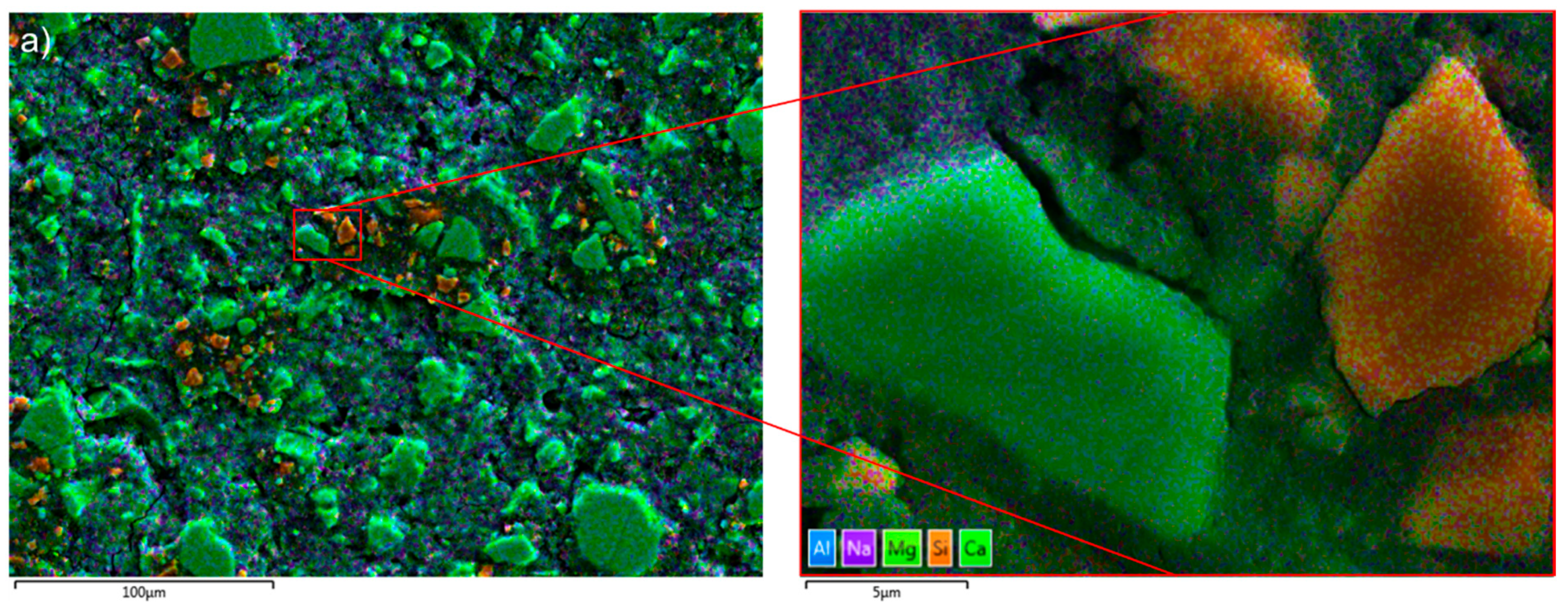

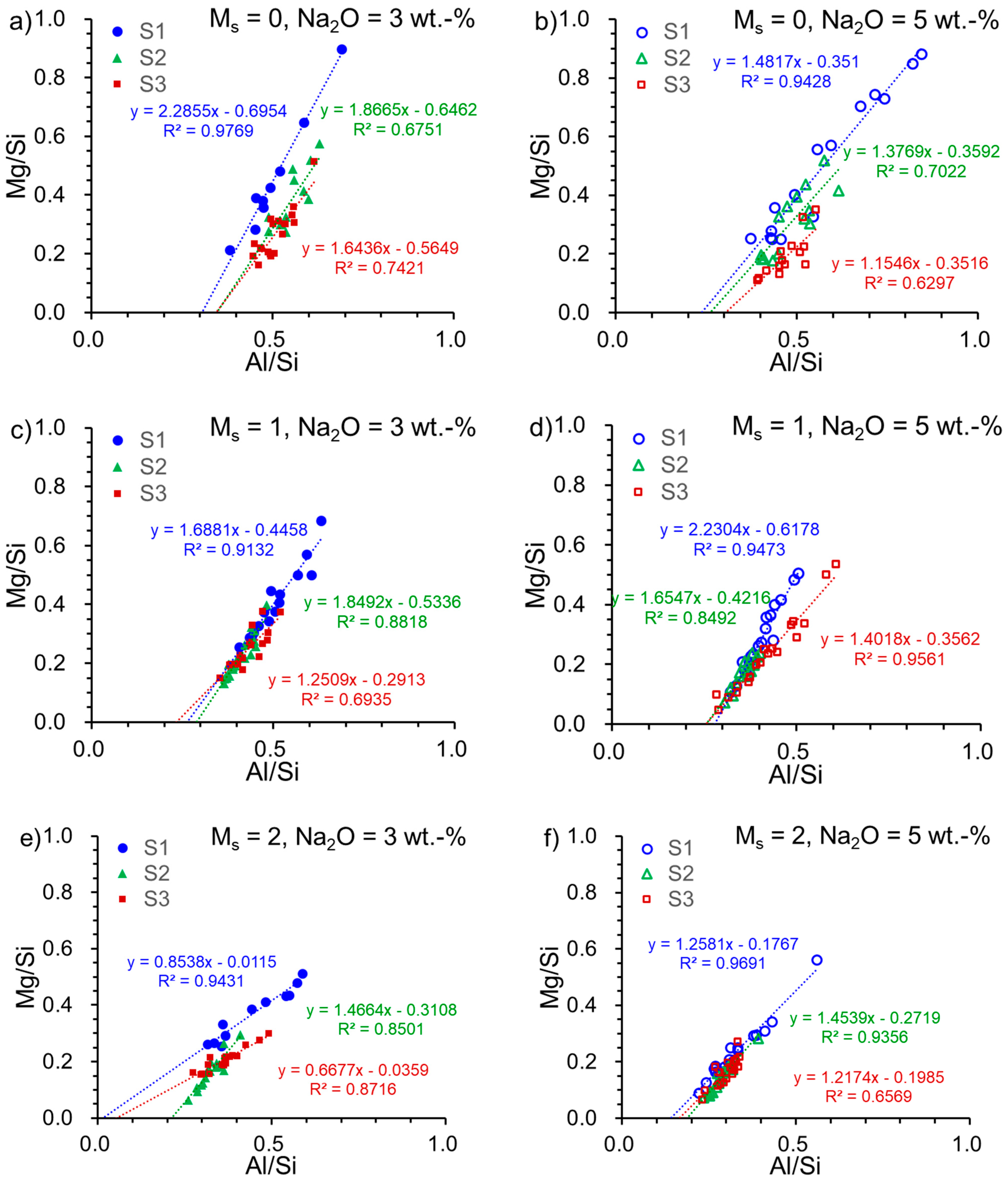
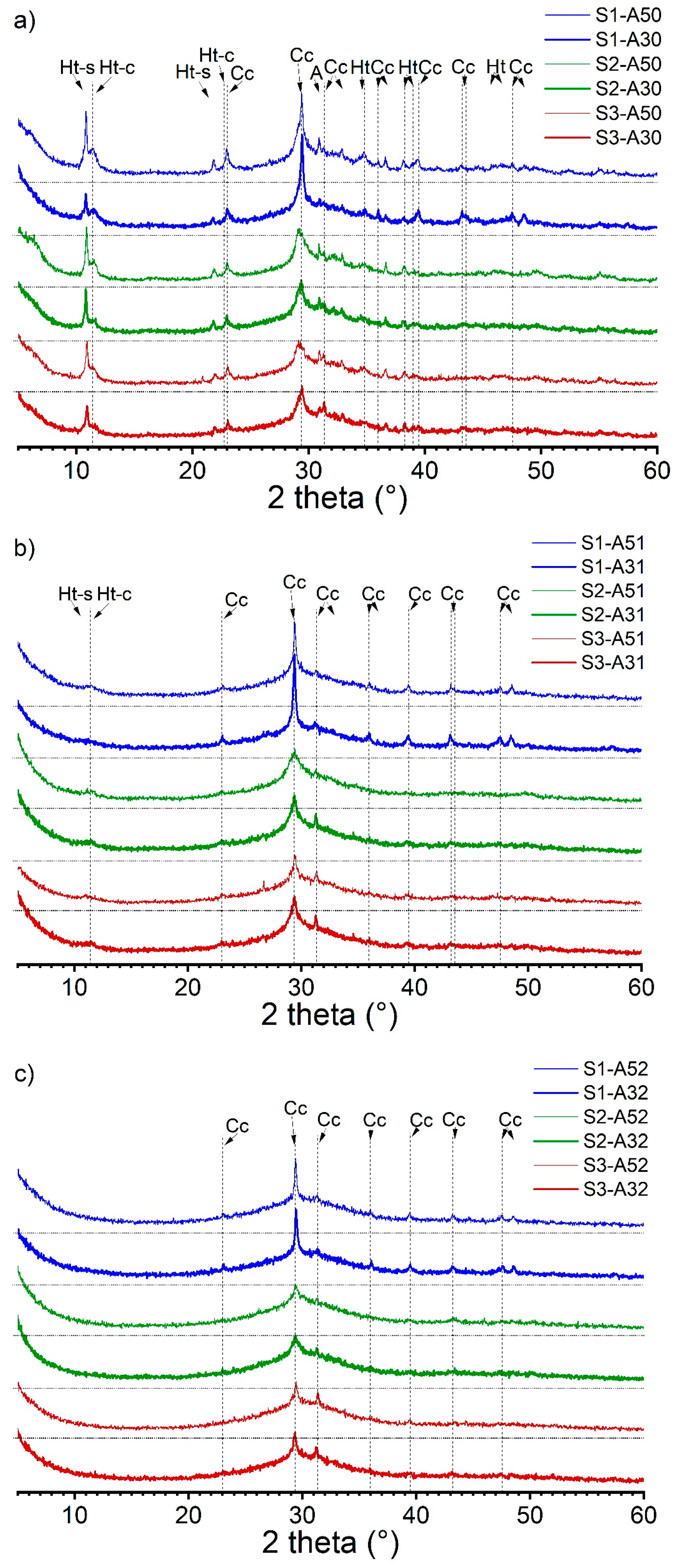

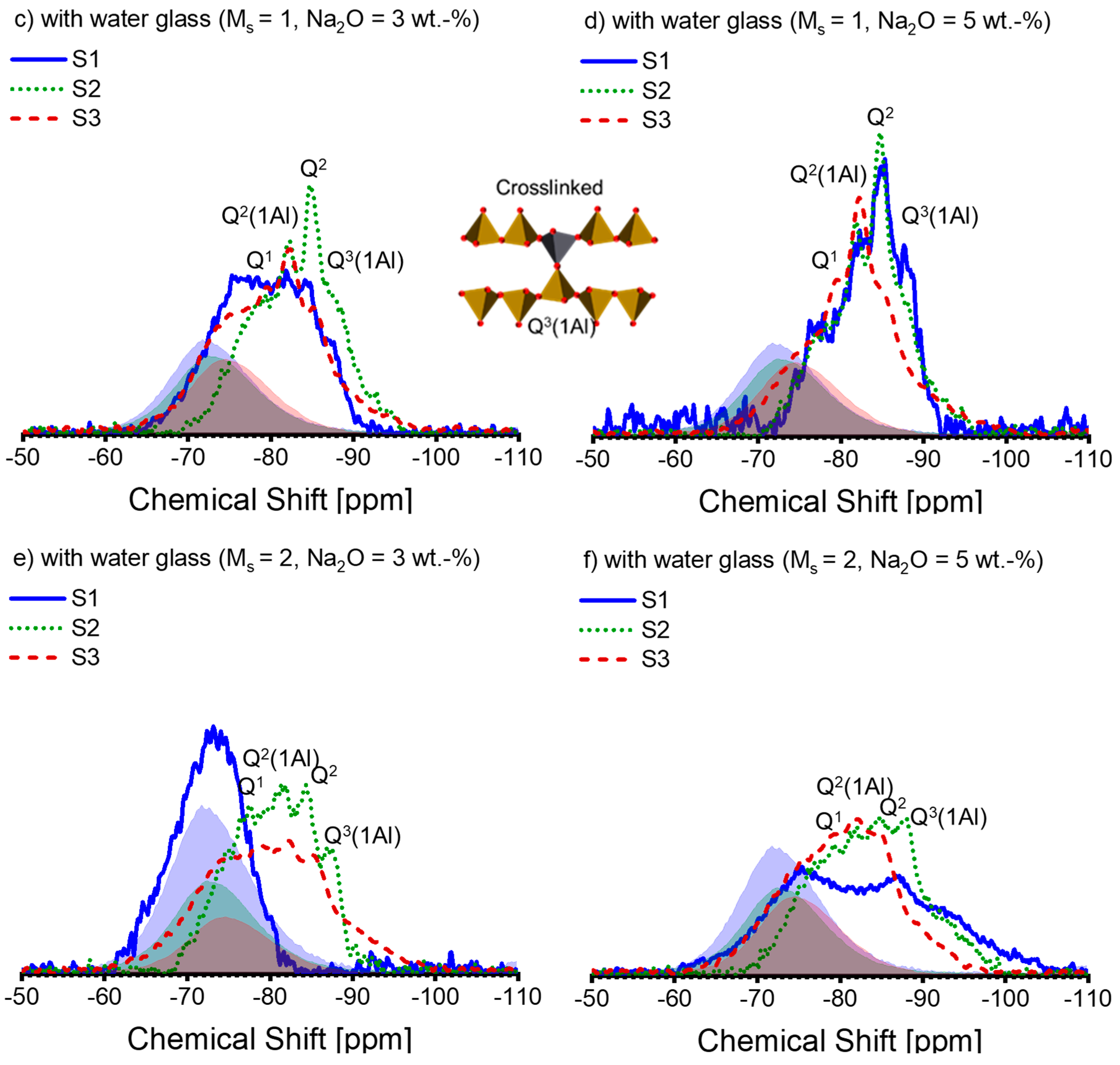
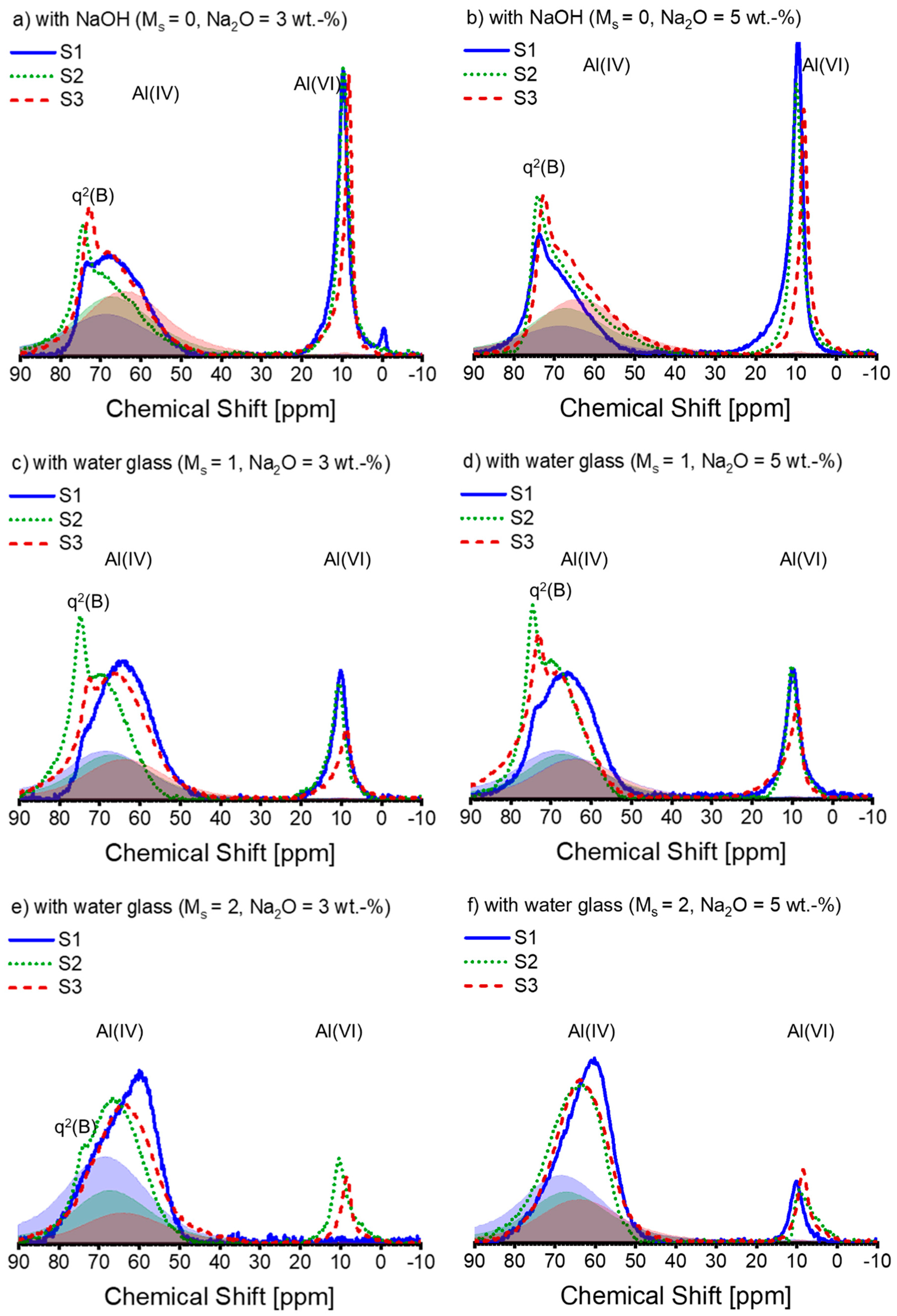
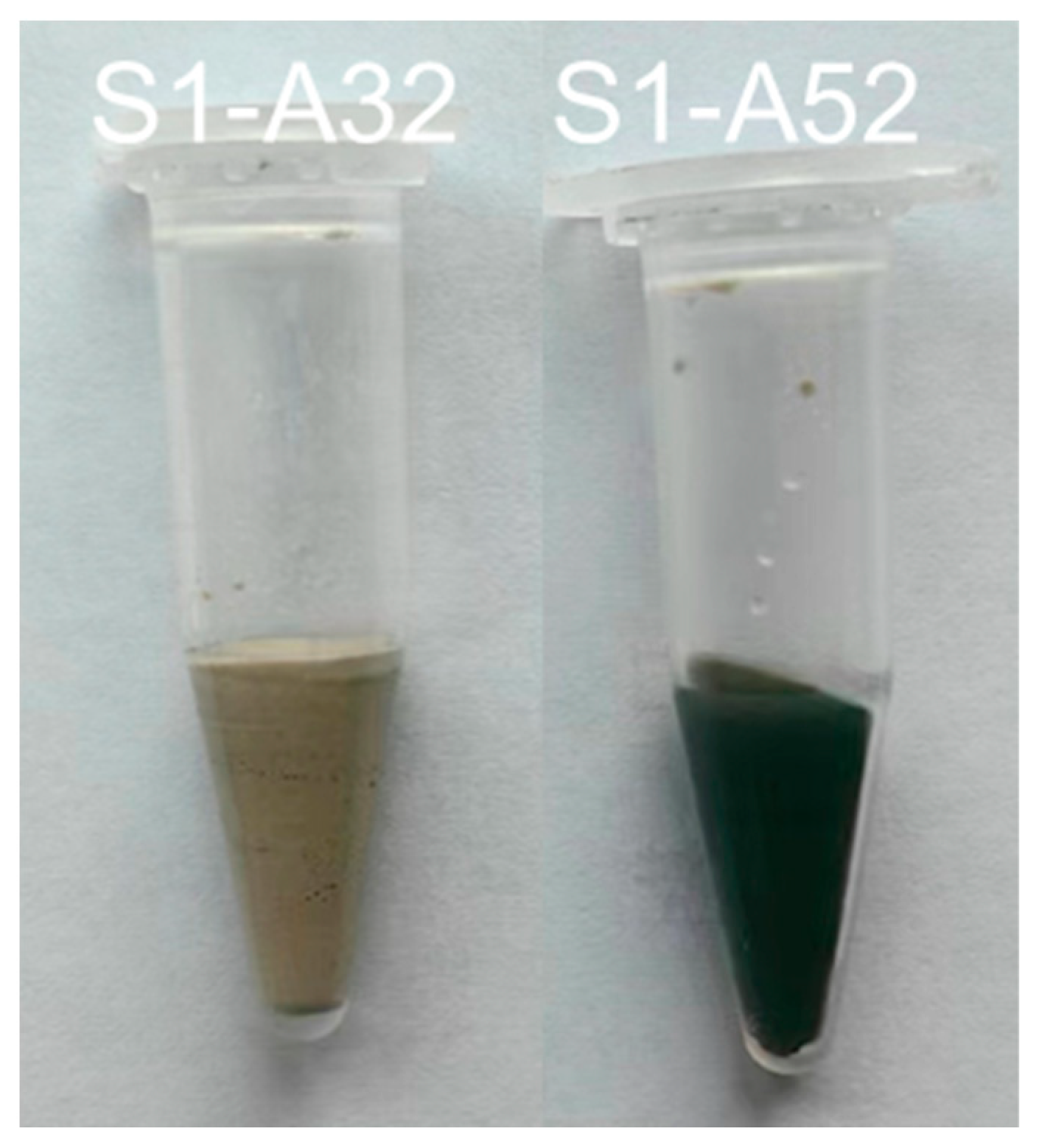
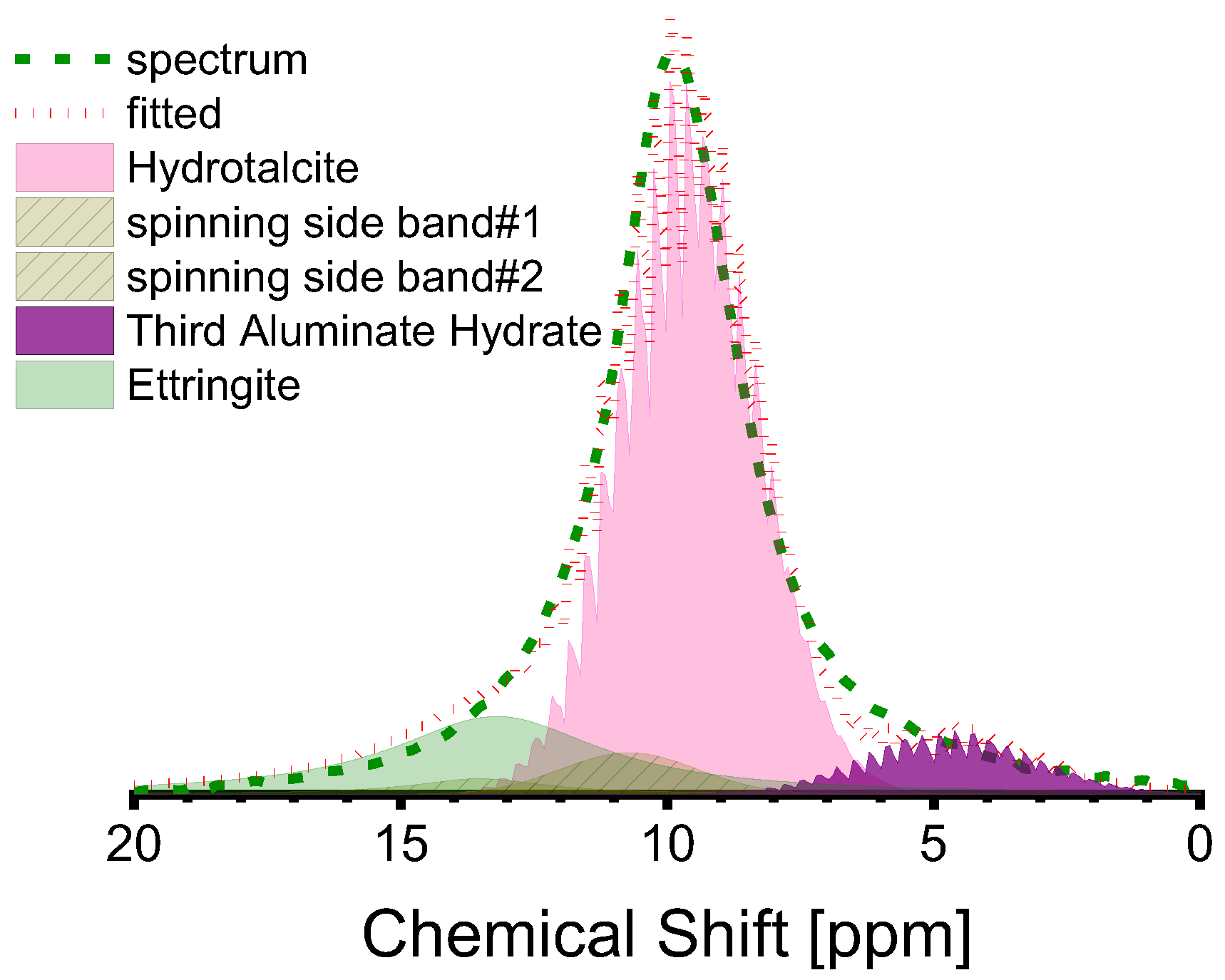


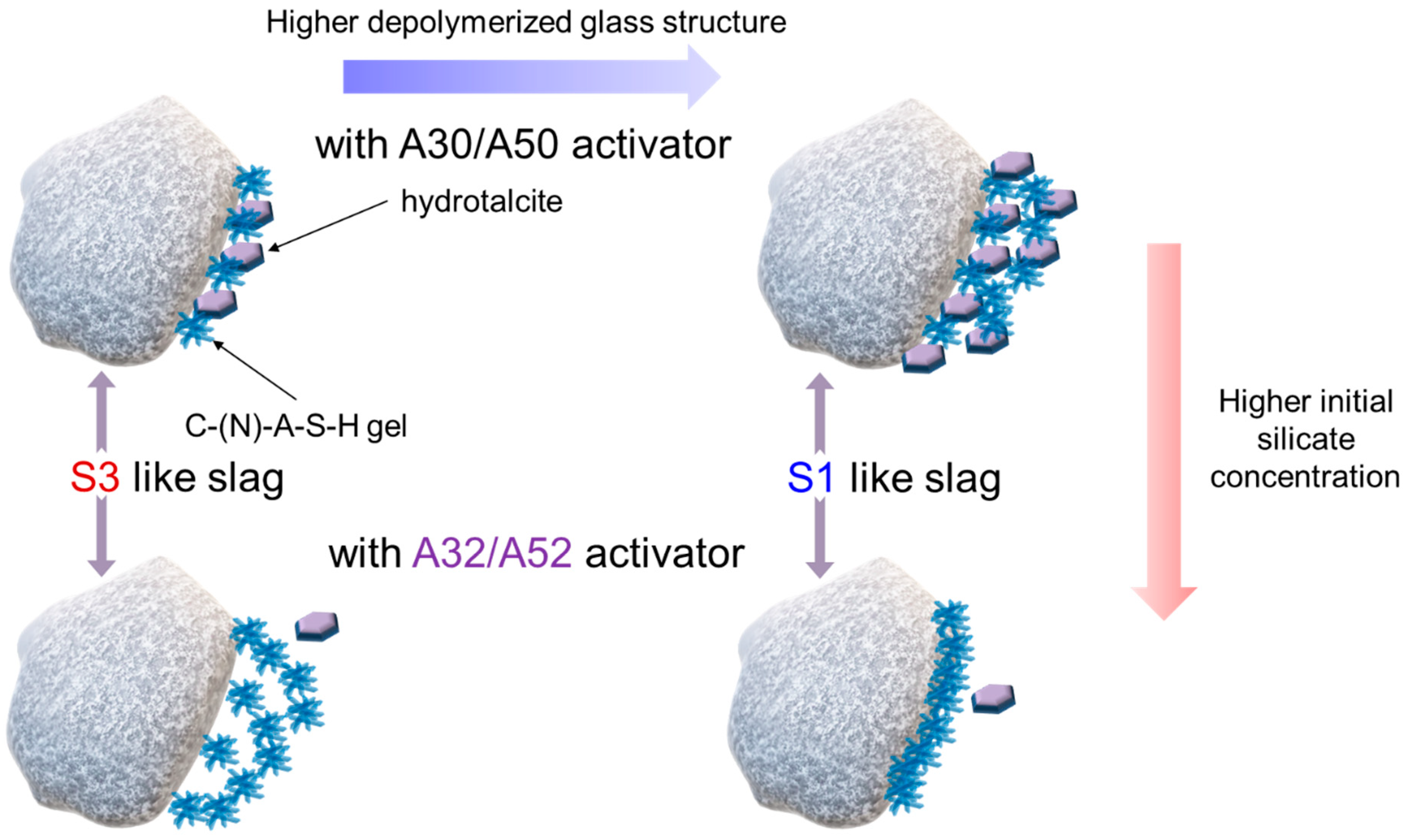
| SiO2 | Al2O3 | TiO2 | MnO | CaO | MgO | Na2O | K2O | SO3 † | Al/Si | Basicity ‡ | |
|---|---|---|---|---|---|---|---|---|---|---|---|
| S1 | 28.4 | 15.4 | 1.66 | 0.31 | 41.0 * | 9.93 | 0.30 | 0.40 | 2.65 | 0.64 | 1.15 |
| S2 | 31.9 | 14.5 | 0.71 | 0.21 | 42.8 | 6.71 | 0.42 | 0.49 | 2.23 | 0.53 | 1.07 |
| S3 | 31.8 | 16.6 | 1.05 | 0.40 | 39.7 | 7.22 | 0.65 | 0.45 | 1.40 | 0.61 | 0.97 |
| Amorphous | Åkermanite | Calcite * | |
|---|---|---|---|
| S1 | 93.6 | 3.0 | 3.4 |
| S2 | 96.4 | 3.6 | not detected |
| S3 | 93.2 | 6.8 | not detected |
| Item\No. | A30 | A50 | A31 | A51 | A32 | A52 |
|---|---|---|---|---|---|---|
| Na2O dosage | 3% | 5% | 3% | 5% | 3% | 5% |
| Modulus of water glass * (Na2O·nSiO2) | 0 | 0 | 1 | 1 | 2 | 2 |
| Molality of alkali concentration (mol/kg solvent) † | 2.15 | 3.58 | 2.15 | 3.58 | 2.15 | 3.58 |
| Solid content † % by mass of solution | 7.9% | 12.6% | 12.5% | 19.3% | 16.4% | 24.6% |
| Slag\Activator | A30 | A50 | A31 | A51 | A32 | A52 |
|---|---|---|---|---|---|---|
| S1 | 60.1 ± 1.0 | 72.9 ± 6.5 | 53.2 ± 1.0 | 54.0 ± 0.2 | 16.5 ± 2.1 | 36.0 ± 4.2 |
| S2 | 47.3 ± 3.0 | 59.1 ± 5.1 | 59.9 ± 1.5 | 60.8 ± 3.0 | 52.7 ± 3.5 | 55.4 ± 1.7 |
| S3 | 41.4 ± 3.0 | 49.8 ± 2.9 | 63.3 ± 1.9 | 64.2 ± 0.6 | 72.4 ± 1.2 | 61.5 ± 0.6 |
| Slag\Activator | A30 | A50 | A31 | A51 | A32 | A52 | |
|---|---|---|---|---|---|---|---|
| Slope | S1 | 2.29 | 1.48 | 1.69 | 2.23 | 0.85 | 1.26 |
| S2 | 1.87 | 1.38 | 1.85 | 1.65 | 1.47 | 1.45 | |
| S3 | 1.64 | 1.15 | 1.25 | 1.40 | 0.67 | 1.22 | |
| Intercept | S1 | 0.30 | 0.24 | 0.26 | 0.28 | 0.01 | 0.14 |
| S2 | 0.35 | 0.26 | 0.29 | 0.26 | 0.21 | 0.19 | |
| S3 | 0.34 | 0.31 | 0.23 | 0.25 | 0.05 | 0.16 |
| Slag–Activator | Relative Integral Area * (%) | Isotropic Chemical Shift (ppm) | Quadrupolar Coupling Constant (MHz) | Assignment |
|---|---|---|---|---|
| S1-A30 | 31.3 | 13.2 † | /‡ | ettringite |
| 56.0 | 10.0 | 1.18 | hydrotalcite | |
| 6.1 | 5.0 | 1.07 | TAH | |
| 3.1 | 0.0 | 1.15 | TAH | |
| S2-A30 | 80.5 | 10.2 | 1.85 | hydrotalcite |
| S3-A30 | 24.0 | 13.2 | / | ettringite |
| 44.5 | 9.1 | 1.38 | hydrotalcite | |
| 1.4 | 4.9 | 0.88 | TAH | |
| S1-A31 | 53.7 | 13.2 | / | ettringite |
| 43.2 | 10.1 | 1.24 | hydrotalcite | |
| 3.1 | 4.9 | 0.87 | TAH | |
| S2-A31 | 63.9 | 13.2 | / | ettringite |
| 33.9 | 10.1 | 1.04 | hydrotalcite | |
| 2.2 | 5.1 | 0.86 | TAH | |
| S3-A31 | 36.3 | 13.2 | / | ettringite |
| 59.6 | 9.2 | 1.37 | hydrotalcite | |
| 4.1 | 4.2 | 1.21 | TAH | |
| S1-A32 | N.A. | N.A. | N.A. | N.A. |
| S2-A32 | 27.9 | 13.2 | / | ettringite |
| 59.6 | 10.2 | 1.42 | hydrotalcite | |
| 12.5 | 5.3 | 1.89 | TAH | |
| S3-A32 | 20.7 | 13.2 | / | ettringite |
| 56.4 | 9.2 | 1.48 | hydrotalcite | |
| 22.9 | 5.4 | 1.17 | TAH | |
| S1-A50 | 36.7 | 13.2 | / | ettringite |
| 50.2 | 9.4 | 1.14 | hydrotalcite | |
| S2-A50 | 17.4 | 13.2 | / | ettringite |
| 63.1 | 10.0 | 1.21 | hydrotalcite | |
| 6.6 | 5.0 | 1.04 | TAH | |
| S3-A50 | 14.6 | 13.2 | / | ettringite |
| 65.6 | 9.0 | 1.75 | hydrotalcite | |
| 19.8 | 5.2 | 1.15 | TAH | |
| S1-A51 | 21.7 | 13.2 | / | ettringite |
| 66.2 | 10.1 | 1.31 | hydrotalcite | |
| 12.2 | 5.8 | 1.23 | TAH | |
| S2-A51 | 21.8 | 13.2 | / | ettringite |
| 70.8 | 10.1 | 1.11 | hydrotalcite | |
| 7.4 | 5.0 | 0.97 | TAH | |
| S3-A51 | 25.8 | 13.2 | / | ettringite |
| 57.0 | 9.1 | 1.17 | hydrotalcite | |
| 17.2 | 5.1 | 1.25 | TAH | |
| S1-A52 | 100 | 10.3 | 1.22 | hydrotalcite |
| S2-A52 | 58.2 | 9.5 | 1.29 | hydrotalcite |
| 41.8 | 5.0 | 1.17 | TAH | |
| S3-A52 | 70.8 | 9.1 | 1.23 | hydrotalcite |
| 29.2 | 5.1 | 1.15 | TAH |
| Ratio | Slag/Activator | A30 | A31 | A32 | A50 | A51 | A52 |
|---|---|---|---|---|---|---|---|
| Al(VI) | S1 | 41.0 * | 21.8 | 2.5 | 48.1 * | 23.7 | 9.3 |
| S2 | 38.5 * | 20.6 | 16.6 | 36.1 * | 19.4 | 11.1 | |
| S3 | 30.4 * | 13.5 | 10.3 | 28.0 * | 19.7 | 11.8 | |
| non-Al-O-Si | S1 | 36.7 | 21.1 | / | 44.6 | 20.8 | 9.3 |
| S2 | 31.4 | 20.2 | 14.5 | 31.4 | 17.9 | 6.5 | |
| S3 | 20.8 | 12.9 | 8.0 | 22.4 | 16.3 | 8.3 |
Disclaimer/Publisher’s Note: The statements, opinions and data contained in all publications are solely those of the individual author(s) and contributor(s) and not of MDPI and/or the editor(s). MDPI and/or the editor(s) disclaim responsibility for any injury to people or property resulting from any ideas, methods, instructions or products referred to in the content. |
© 2023 by the authors. Licensee MDPI, Basel, Switzerland. This article is an open access article distributed under the terms and conditions of the Creative Commons Attribution (CC BY) license (https://creativecommons.org/licenses/by/4.0/).
Share and Cite
Jin, Y.; Feng, W.; Zheng, D.; Dong, Z. Interaction Mechanism between Slags and Alkali Silicate Activators: An Approach Based on the Al Phases. Materials 2023, 16, 7032. https://doi.org/10.3390/ma16217032
Jin Y, Feng W, Zheng D, Dong Z. Interaction Mechanism between Slags and Alkali Silicate Activators: An Approach Based on the Al Phases. Materials. 2023; 16(21):7032. https://doi.org/10.3390/ma16217032
Chicago/Turabian StyleJin, Yu, Weipeng Feng, Dapeng Zheng, and Zhijun Dong. 2023. "Interaction Mechanism between Slags and Alkali Silicate Activators: An Approach Based on the Al Phases" Materials 16, no. 21: 7032. https://doi.org/10.3390/ma16217032
APA StyleJin, Y., Feng, W., Zheng, D., & Dong, Z. (2023). Interaction Mechanism between Slags and Alkali Silicate Activators: An Approach Based on the Al Phases. Materials, 16(21), 7032. https://doi.org/10.3390/ma16217032







